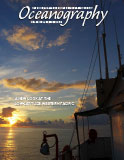Article Abstract
Current structure, transport, and water mass properties of the northward-flowing Kuroshio and the southward-flowing Luzon Undercurrent (LU) were observed for nearly one year, June 8, 2012–June 4, 2013, across the Kuroshio path at 18.75°N. Observations were made from four platforms: an array of six subsurface ADCP moorings, two Seagliders, fivepressure inverted echo sounders (PIES), and five horizontal electric field (HEF) sensors, providing the most detailed time series of the Kuroshio and Luzon Undercurrent water properties to date. Ocean state estimates of the western boundary current system were performed using the MIT general circulation model—four-dimensional variational assimilation (MITgcm-4D-Var) system. Prominent Kuroshio features from observations are simulated well by the numerical model. Annual mean Kuroshio transport, averaged over all platforms, is ~16 Sv with a standard deviation ~4 Sv. Kuroshio and LU transports and water mass pathways east of Luzon are revealed by Seaglider measurements. In a layer above the salinity maximum associated with North Pacific Tropical Water (NPTW), Kuroshio transport is ~7 Sv and contains North Equatorial Current (NEC) and Western Philippine Sea (WPS) waters, with an insignificant amount of South China Sea water on the shallow western flank. In an intermediate layer containing the core of the NPTW, Kuroshio transport is ~10 Sv, consisting mostly of NEC water. In the lower layer of the Kuroshio, transport is ~1.5 Sv of mostly North Pacific Intermediate Water (NPIW) as a part of WPS waters. Annual mean Luzon Undercurrent southward transport integrated to 1,000 m depth is ~2.7 Sv with a standard deviation ~2 Sv, carrying solely WPS waters below the salinity minimum of the NPIW. The transport of the western boundary current integrated over the full ocean depth east of Luzon Island is ~14 ± 4.5 Sv. Sources of the water masses in the Kuroshio and Luzon Undercurrent are confirmed qualitatively by the numerical model.

